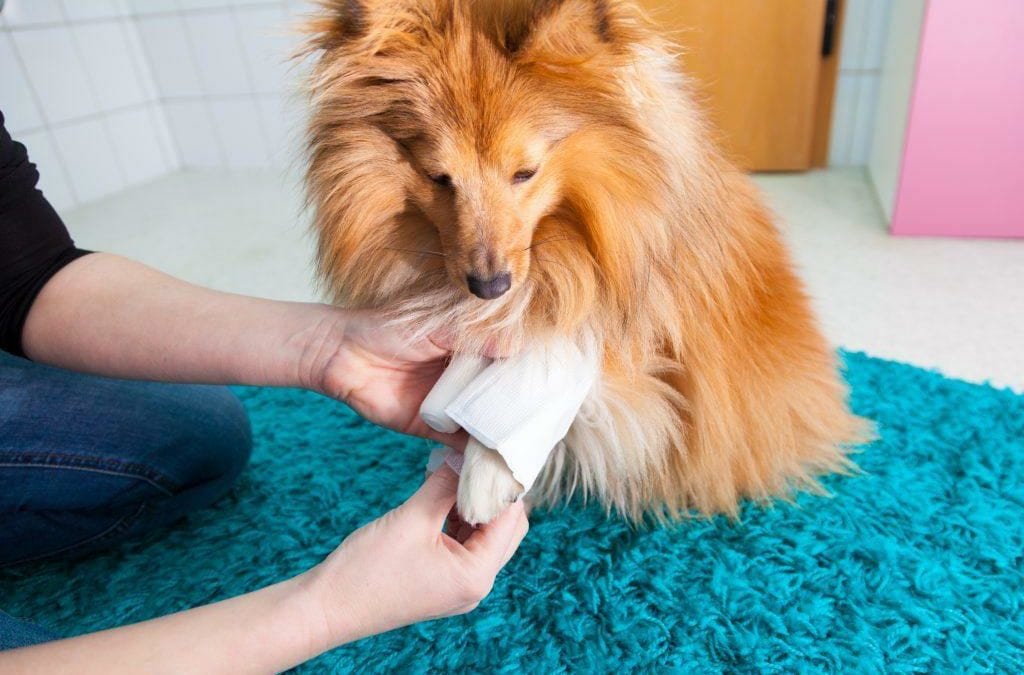In addition to all the important day-to-day elements of pet ownership, organizing a pet first-aid kit is another key component of responsible pet care. After all, pets experience occasional injury, just like us. If left alone, pet wounds can present a serious risks to your pet’s overall health. However, when you know what to do about pet wounds, and have all the right supplies, a minor injury can be healed with ease.
On Hand and Immediate
Depending on the severity, pet wounds warrant either minor or emergency care. Knowing the difference between the two is paramount to the outcome. While administering care at home can buy your pet time, seeking care immediately is always a good choice. If you ever have any doubt, we encourage you to contact us.
Assessing the Damage
If your pet is bleeding, limping, or behaving oddly, take a close look. An injury that penetrates the skin, such as an animal bite, should be seen immediately by a veterinarian. Sometimes, pockets beneath the skin need draining or the puncture can go deeper than initially thought.
Pet wounds can often be deceptive. Cats and dogs have fewer capillaries than we do, so when there’s less blood, it can be difficult to discern the severity of an injury.
Danger of Pet Wounds
A pet first-aid kit should include the following:
- Basics—Cold packs, rectal thermometer, sterile lubricant, splint materials, emergency blanket
- Wound care—Latex gloves, eye wash, topical antibiotic ointment, sponges, antiseptic soap, gauze, sponges, sterile saline
- Wraps—Gauze, elastic bandage material, adhesive tape, scissors
- Bonus—Safety pins, flashlight, tweezers, muzzle, needle-nose pliers
If you feel confident an injury is minor enough to treat at home, try the following:
- Wash out the wound with a clean towel, warm water, and non-stinging antiseptic solution
- Apply an antimicrobial ointment
- Leave it uncovered for a minimum of 10 minutes
- Discourage any licking of the wound
If you notice any redness, inflammation, swelling, or pus, please give us a call.
Prevent Infection
If you can’t properly restrain your pet, it’s best to bring him or her in quickly. Pets are typically very resistant to any attention given to injuries, but it’s vital to keep pet wounds clean – especially if sutures are required.
Serious pet wounds that aren’t addressed in time will result in infection. Treatment can involve an open wound management plan with recurrent bandaging and antibiotics over a period of weeks.
What to Expect
Sedation is usually necessary to thoroughly inspect and treat pet wounds. Once your pet is calm and still, we can assess the extent of the injury and possibly complete any of these steps:
Clean the area with sterile antiseptic solutionClip or shave any surrounding hairAdminister local anesthetic to numb the areaApply suturesInject antibiotics and pain medication
If your pet suffers from more than one wound or has deeper cuts, bites, or scratches than previously thought, full anesthesia may be necessary.
Signs and Doubts
Since he or she can’t articulate the pain, playing it safe is always the best option for your pet. Our emergency staff is available 7 days a week, and we hope you’ll let us know how we can be of assistance.

